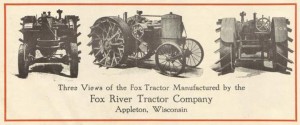During the years of World War I and after, at least until the severe agricultural depression of 1921, tractor manufacturers and wannabes, as well as not a few charlatans who only hoped to sell stock in non-existent tractor companies, were thick on the ground, especially in the Midwest.
One of the wannabes, the Fox River Tractor Co., actually went on to become a successful manufacturer, although not of tractors, and lasted well into the 1980s. The Fox River story really begins in 1881, in Appleton, Wisconsin, along the Fox River, when Richard Miller and two others established the eagle Fork Co. to manufacture a line of haying tools.
Three years later, Miller sold his block of shares to three brothers, Edward, Frank and Oscar Saiberlich, who began to make ensilage cutters, which proved very successful.
New direction
The name was changed to the Eagle Manufacturing Co. in 1888, and by the turn of the century they were experimenting with the new-fangled gasoline engine.
By 1908, the Eagle firm had diversified and was building ensilage cutters and blowers, burr mills and feed grinders, sweep horse powers, one-cylinder gas engines, and engine powered saws. Experiments with gasoline tractors were ongoing as well, and a heavy, 4-cylinder, 45 hp model was introduced in 1911. Business prospered and with the demands of war production, a new factory was needed.
The Saiberlich family needed capital and they were persuaded to sell stock in the company to raise money. Soon the new stockholders demanded more say in operations and some of the Saberlichs felt they were being pushed out. Frank and Oscar Saiberlich sold their Eagle shares in 1918 and a year later started the Fox River Tractor Co. in Appleton. Their new tractor, called the Fox 20-40, had a 4-cylinder, horizontally opposed engine of 5 x 7 inch bore and stroke.
It was 138 inches long, 72 wide, weighed 6,700 pounds, and was said to sell for $3,100. It’s unclear who designed the Fox tractor — I can find no patents for it — but it closely resembles the Eagle tractors of 1916 through 1918 and was undoubtedly patterned after the Eagle.

The Appleton Post-Crescent wrote in its Oct. 15, 1920, issue: “The first Fox tractor produced by the Fox River Tractor Company is making good in actual farm tests. The machine was placed on the Rudolph Schaefer farm near Appleton this summer and has been used for silo filling, threshing and plowing. Mr. Schaefer found that it had plenty of belt power for all work required, and was surprised to find it capable of plowing with ease at full speed.”
More tractors
The story went on, “The second machine is all erected at the Fox River plant and is ready for the paint shop. It has been tested out and found to be fully equal to the original model. About 10 tractors of the 20-40 type will be built during the winter months.”
A Fox 20-40 was exhibited in Milwaukee that December at the Wisconsin Implement dealers’ Association annual show where “it attracted a great deal of attention.”
Frank Saiberlich announced at the end of 1920 that the Fox River Tractor Company was preparing for a busy season in 1921.
“I cannot see how it can be otherwise, for tractors are needed for both farm and road work. The company has the material assembled and work well advanced on twelve, which will be completed before spring.”
Not exactly assembly line speed — twelve tractors in four months. From June 28 to 30, 1921, the national tractor demonstrations were held in Fargo, North Dakota, and Fox sent up a Model 20-40 to take part.
More power
The newspaper reported: “The Fox tractor was assigned to the last 10-acre plot toward the Cheyenne River. The nature of the soil and the obstacles to be overcome afforded opportunity to demonstrate its reserve power. The Appleton machines (which also included two Eagle tractors) kept well in the lead in the tests, and expect to own some of the best records when the results are announced.”
An interesting tid-bit was in the Jan. 28, 1922, issue of the Post-Crescent, headlined Fox River Tractor Company Invents New Machine for Highway Work.
The story goes on, “Fox River Tractor Co. is about to put a new tractor on the market designed expressly for road work. It is to be heavier than the one the company at present manufactures, weighing about 8,500 pounds and will have a slower speed. The need of a new tractor designed particularly for road work was called to the attention of the company last fall when it exhibited its tractor at several fairs.
“The company could easily have made several sales to road contractors, had its tractors been heavier and of the lower speed for this kind of work. The road men claimed they need a machine with especially heavy drive wheels and slow speed besides an abundance of power.”
Many unknowns
No one seems to know if any of these heavy road tractors were ever built, or how many of the Fox Model 20-40s were made. Considering the hard times that struck farmers at the time, and the fact that the Fox at $3,100 was rather costly, probably not many were made or sold.
A Fordson could be bought in 1921 for a little more than $600, and while the Fox was a 4-plow machine and the Fordson only a two, it was still a whopping difference. So the Saiberlichs wisely dropped the Fox tractor and concentrated on ensilage machines, while working with Professor Waldo Duffee of the University of Wisconsin to perfect a field hay chopper, better known as a forage harvester.
All through the latter half of the 20th century, Fox forage harvesters carried an excellent reputation and were very popular among dairy farmers.












